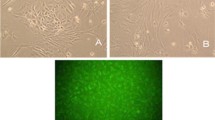Abstract
(−)-Epigallocatechin gallate (EGCG) is the main polyphenol component of green tea (leaves of the Camellia sinensis plant). EGCG has been reported to protect human brain microvascular endothelial cells (HBMECs) against injury in several models. However, the exact mechanism is still unclear. In the current study we found that EGCG protected against asymmetric dimethylarginine (ADMA)-induced HBMEC injury, and inhibited ADMA-induced reactive oxygen species production and malondialdehyde expression. At the same time, we found that pretreatment with EGCG attenuated the upregulation of Bax and the downregulation of Bcl-2, thus confirming the cellular protective properties of EGCG against ADMA-induced apoptosis. Furthermore, we found that EGCG inhibited ADMA-induced phosphorylation of ERK1/2 and p-38, whose inhibitors relieved HBMEC injury. In conclusion, EGCG can protect against ADMA-induced HBMEC injury via the ERK1/2 and p38 MAPK pathways, which are involved in the underlying mechanisms of HBMEC injury in cerebral infarction.





Similar content being viewed by others
References
Kumar A, Prasad M, Kumar P et al (2015) Association between beta adrenergic receptor polymorphism and ischemic stroke: a meta-analysis. J Stroke 17(2):138–143
Wang J, Yang W, Xie H et al (2014) Ischemic stroke and repair: current trends in research and tissue engineering treatments. Regen Med Res 2(1):3
Vella J, Zammit C, Di Giovanni G et al (2015) The central role of aquaporins in the pathophysiology of ischemic stroke. Front Cell Neurosci 9:108–126
Przybylowski CJ, Ding D, Starke RM et al (2014) Evolution of endovascular mechanical thrombectomy for acute ischemic stroke. World J Clin Cases 2(11):614–622
Chen H, Yao K, Chang X et al (2015) Computational and biochemical discovery of RSK2 as a novel target for epigallocatechin gallate (EGCG). PLoS One 10(6):e0130049
McLaughlin N, Annabi B, Bouzeghrane M et al (2006) The Survivin-mediated radioresistant phenotype of glioblastomas is regulated by RhoA and inhibited by the green tea polyphenol (−)-epigallocatechin-3-gallate. Brain Res 1:1–9
Baatout S, Jacquet P, Derradji H et al (2004) Study of the combined effect of X-irradiation and epigallocatechin-gallate (a tea component) on the growth inhibition and induction of apoptosis in human cancer cell lines. Oncol Rep 12(1):159–167
Ahmad N, Cheng P, Mukhtar H (2000) Cell cycle dysregulation by green tea polyphenol epigallocatechin-3-gallate. Biochem Biophys Res Commun 275(2):328–334
Yokoyama S, Hirano H, Wakimaru N et al (2001) Inhibitory effect of epigallocatechin-gallate on brain tumor cell lines in vitro. Neuro Oncol 3(1):22–28
Choi YB, Kim YI, Lee KS et al (2004) Protective effect of epigallocatechin gallate on brain damage after transient middle cerebral artery occlusion in rats. Brain Res 1–2:47–54
Lin AM, Chyi BY, Wu LY et al (1998) The antioxidative property of green tea against iron-induced oxidative stress in rat brain. Chin J Physiol 41(4):189–194
Lee S, Suh S, Kim S (2000) Protective effects of the green tea polyphenol (−)-epigallocatechin gallate against hippocampal neuronal damage after transient global ischemia in gerbils. Neurosci Lett 287(3):191–194
Tang WJ, Hu CP, Chen MF et al (2006) Epigallocatechin gallate preserves endothelial function by reducing the endogenous nitric oxide synthase inhibitor level. Can J Physiol Pharmacol 84(2):163–171
Mamatha SN, Nagaraja D, Philip M et al (2011) Asymmetric dimethylarginine as a risk marker for early-onset ischemic stroke in Indian population. Clin Chim Acta 412(1–2):139–142
Yoo JH, Lee SC (2001) Elevated levels of plasma homocyst(e)ine and asymmetric dimethylarginine in elderly patients with stroke. Atherosclerosis 158(2):425–430
Nishiyama Y, Ueda M, Katsura K et al (2010) Asymmetric dimethylarginine (ADMA) as a possible risk marker for ischemic stroke. J Neurol Sci 290(1–2):12–15
Lv Q, Gu C, Chen C (2014) Venlafaxine protects methylglyoxal-induced apoptosis in the cultured human brain microvascular endothelial cells. Neurosci Lett 569:99–103
Guo W, Ding J, Zhang A et al (2014) The inhibitory effect of quercetin on asymmetric dimethylarginine-induced apoptosis is mediated by the endoplasmic reticulum stress pathway in glomerular endothelial cells. Int J Mol Sci 15(1):484–503
Li W, Xu H, Hu Y et al (2013) Edaravone protected human brain microvascular endothelial cells from methylglyoxal-induced injury by inhibiting AGEs/RAGE/oxidative stress. PLoS One 8(9):e76025
Nour EE, Almarzouki A, Assiri AM et al (2014) Oxidized low density lipoprotein and total antioxidant capacity in type-2 diabetic and impaired glucose tolerance Saudi men. Diabetol Metab Syndr 6(1):94
Liu Y, Shi L, Liu C et al (2015) Effect of combination therapy of propofol and sevoflurane on MAP2K3 level and myocardial apoptosis induced by ischemia-reperfusion in rats. Int J Clin Exp Med 8(4):6427–6435
Li J, Ye L, Wang X et al (2012) (−)-Epigallocatechin gallate inhibits endotoxin-induced expression of inflammatory cytokines in human cerebral microvascular endothelial cells. J Neuroinflamm 9:161
Jiang DJ, Jia SJ, Dai Z et al (2006) Asymmetric dimethylarginine induces apoptosis via p38 MAPK/caspase-3-dependent signaling pathway in endothelial cells. J Mol Cell Cardiol 40(4):529–539
Hankey GJ (2006) Potential new risk factors for ischemic stroke: what is their potential? Stroke 37(8):2181–2188
Goldstein LB, Adams R, Becker K et al (2001) Primary prevention of ischemic stroke: a statement for healthcare professionals from the Stroke Council of the American Heart Association. Stroke 32(1):280–299
Ozaki K, Tanaka T (2016) Molecular genetics of coronary artery disease. J Hum Genet 61(1):71–77
Pae M, Wu D (2013) Immunomodulating effects of epigallocatechin-3-gallate from green tea: mechanisms and applications. Food Funct 4(9):1287–1303
Chen S, Li N, Deb-Chatterji M et al (2012) Asymmetric dimethyarginine as marker and mediator in ischemic stroke. Int J Mol Sci 13(12):15983–16004
Li L, Li W, Jung SW et al (2011) Protective effects of decursin and decursinol angelate against amyloid beta-protein-induced oxidative stress in the PC12 cell line: the role of Nrf2 and antioxidant enzymes. Biosci Biotechnol Biochem 75(3):434–442
Author information
Authors and Affiliations
Corresponding author
Ethics declarations
Conflict of interest
None.
Additional information
Jia Li and Changlin Zou contributed equally to this work as the co-first author.
Rights and permissions
About this article
Cite this article
Li, J., Zhang, Z., Lv, L. et al. (−)-Epigallocatechin Gallate Inhibits Asymmetric Dimethylarginine-Induced Injury in Human Brain Microvascular Endothelial Cells. Neurochem Res 41, 1868–1876 (2016). https://doi.org/10.1007/s11064-016-1898-9
Received:
Revised:
Accepted:
Published:
Issue Date:
DOI: https://doi.org/10.1007/s11064-016-1898-9




